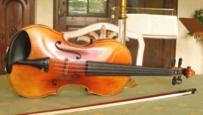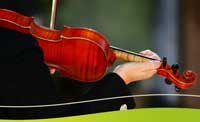Introduction to the Violin
The violin is the upper voice in the stringed instrument family. The early history of the violin is rather vague.
Chances are likely that an early predecessor came from China and India, and migrated somehow to Italy, where it came to be known as an arm viol, and around 1700, was updated from the Baroque version to what we know as the modern version, suitable to the large concert halls which developed in response to the industrial revolution.

These are the open strings of the violin.
|
The violin has a human shape and a human voice, appropriate for the country of its modern origin; Italy, the land of opera and the celebration of the human voice.
It’s very accessible, easy to carry around, and has been used and is used in all sorts of musics; folk music of all sorts from all cultures, and art music of the very highest genre. See: Early Baroque Violin Practice (1520-1650).
The violin plays a profound role in chamber music, orchestral music, opera, ballet, and the solo repertoire.
Orchestral scores are written with violin sections one and two; the classical quartet has two violins (and one viola and one cello).
The first chair, first violin in an orchestra (called concertmaster, even if female) plays a key leadership role in the group, secondary only to the conductor, and works with the principle players who sit first chair in the second violin, viola, cello and bass sections.
Thus the inner circle of stands in the strings—the first chair players in each string section—forms a sort of string quartet, surrounding the conductor, and this body of players in leadership positions works in conjunction with the first chair players in the wind, brass and percussion sections, particularly with first oboe, who also plays a key leadership role. The orchestra tunes to the oboe’s A 440, which is the pitch standard in orchestras throughout the world.
If you examine an orchestral score, you will see the organization of the score is, from the top, first the lines of the woodwinds, then the brass, then the percussion, and then the strings, continuing in the order of top to bottom: violin I, violin II, viola, cellos, and bass.
If there is a soloist, there will be a separate line for that.
In the sonata literature for violin and piano, the score consists of three lines: the top line in treble clef for the violin, and beneath that (in the score) the piano grand staff, which consists of two lines, a treble clef and a bass clef.
The violin and piano will also have separate parts for reading and performance purposes.
The standard string quartet will also have separate parts for performance, but for purposes of study, the score (often a miniature score) will be seen to have the parts written out in a standard format similar to the lower four lines of an orchestral score, i.e., violin I, violin II, viola and cello, in descending order on the page.
Modern orchestras typically have around 100 players, about two-thirds of which are strings.
Baroque or Early Music chamber groups will be much smaller: as music developed over the past several centuries, orchestras have gotten larger and larger, due to the requirements of the larger halls.
Mahler and Wagner, for example, have very much larger orchestral sections (particularly in the brass) than do, say, Haydn and Mozart.

Vuillaume violin (1862)
|
Thus the solo responsibilities of the
leadership positions in the relatively smaller sections of brass, woodwinds and percussion require a very high level of virtuosity.
This is not to suggest that the string players are not also held to a very high standard. Orchestral positions in major orchestras are extremely difficult to win.
ICSOM (International Conference of Symphony and Opera Musicians) statistics are initially rather discouraging:
- There are 52 ICSOM orchestras employing a total of about 4,200 musicians.
- During the academic year 2002-2003, American colleges, universities and conservatories graduated 14,601 students with degrees in music.
- During the 2003 calendar year there were 159 openings for musicians in ICSOM orchestras.
Young musicians should not be discouraged by this, however, but should be made aware of the many job possibilities in the world of music, aside from positions in major orchestras.
There is a huge shortage of string teachers. According to ASTA (American String Teachers Association) statistics: “24% of string positions went unfilled in 1999-2000, and 43% percent of school districts with string programs had string positions that were not filled in 2000-2001."
Connie Sunday: Freelance studio musician, strings and piano teacher, author of Violin FAQ and numerous essays in violin pedagogy. Further information can be found at connexions.
|

